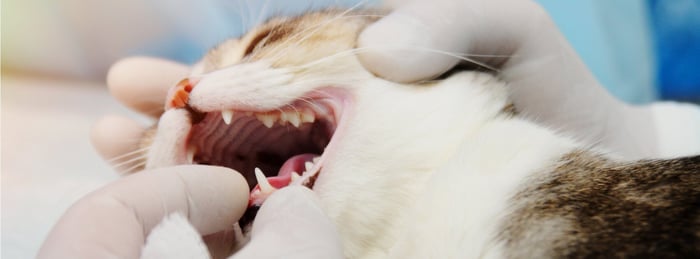Although both gingivitis and stomatitis can be present in cats, their nature is quite different. It’s important that cat owners know this.
Gingivitis in cats
Gingivitis is the first warning sign of impending feline periodontal disease. In medical terms, gingivitis simply means “inflammation of the gums.” Your cat’s mouth is full of bacteria that feed on fragments of food and other material that your cat picks up or licks.
As the bacteria grow, they form a slimy biofilm called plaque, which coats the surfaces of the cat’s teeth. If preventative measures are not taken, the bacteria enter the gingival sulcus, the small pocket between the tooth and the gum, causing irritation and infection. Within a few days, minerals in the cat’s saliva cause the plaque to harden into dental calculus (tartar).
Plaque and tartar gradually extend beneath the gumline, resulting in irritation and inflammation. The gums then become red and swollen around the tooth margins. The cat may have difficulty eating due to the discomfort in their mouth.
Their gums may bleed, and they will almost always develop “bad breath.” If gingivitis is not treated quickly, the condition will progress to full-blown feline periodontal disease. Feline periodontal disease can cause extreme discomfort for your cat, and tooth loss will almost inevitably occur.
In addition, bleeding gums can give bacteria easy access to the bloodstream, where they can be transported throughout the cat’s body. Inflammatory by-products are more harmful, especially if chronic as in periodontal disease, and can cause serious health problems.
Though gingivitis is preventable and curable, periodontitis is not. In fact, brushing your cat’s teeth daily with a pet-specific toothpaste and attending regular veterinary dental checks will effectively prevent gingivitis.
Stomatitis in cats

Stomatitis differs from feline periodontal disease in that it is primarily a paradental disease. This means that it does not only affect the supportive tissues that attach the tooth to the socket in the cat’s jaw (alveolar bone, cementum, periodontal ligament, and gingiva).
Stomatitis typically impacts the soft, fleshy structures inside your cat’s mouth such as the pharynx, oral mucosa, inside of the cheeks, and tongue, as well as the gums, and is typically characterized by the formation of painful, persistent ulcers.
There are a few different types of stomatitis situations that a veterinary dentist can differentiate and treat appropriately. As in cases of gingivitis, the bacteria inside your cat’s mouth can trigger stomatitis, although for different reasons.
Some cats have a hypersensitive immune response to the bacteria that form a coating of plaque on the tooth surfaces. In these animals, excessive amounts of antibodies are produced by the body in order to tackle the invading bacteria, and it is these antibodies that initiate stomatitis. Certain breeds of cats are at a higher risk of developing stomatitis.
In particular, Persians, Siamese, Himalayans, Burmese, Abyssians, and other pure breeds are known to be predisposed to stomatitis (referred to also as Feline Chronic Gingivitis Stomatitsis Syndrome). Stomatitis can also be caused by external triggers, including trauma, ingestion of caustic substances, certain autoimmune diseases, and foreign bodies such as bone and wood splinters becoming embedded in the soft tissue of the mouth.
What are signs of cat stomatitis?
A few stomatitis symptoms are very similar to those presented by gingivitis, which is why the two conditions are often misdiagnosed by concerned cat owners.
Typically, the only way to achieve a definitive and correct diagnosis is through veterinary examination. If your cat shows any of the following symptoms, seek veterinary advice right away:
- foul breath
- bleeding gums
- excessive drooling, sometimes containing blood
- reddened, swollen gums
- reluctance or difficulty eating
- poor appetite
- weight loss
- pawing at the mouth
- obvious lesions or ulcers on the gums (“kissing ulcers”)
- reluctance to groom himself
- depression
- reluctance to allow oral manipulation
You may also notice small areas of inflammation, sometimes exuding pus, in the folds around your cat’s mouth.
How is cat stomatitis diagnosed?
A vet will first carry out an oral examination of your cat to determine whether the symptoms presented are the result of gingivitis or stomatitis. In severe cases, where the cat is in extreme pain, this examination will be performed under anesthesia. Other diagnostic procedures may include biopsies of the lesions to eliminate cancer or autoimmune diseases as a cause.
In addition, standard blood and viral tests, urinalysis, and an electrolyte panel will be performed to ensure that your cat is not suffering from any underlying conditions such as kidney disease or bacterial infections.
In many cases, tooth extraction will be required and X-rays will be necessary so that the extent of bone involvement can be determined.
How is cat stomatitis treated?
There are many treatments that can be used to ease the symptoms caused by stomatitis. Antibiotic, anti-inflammatory, and analgesic therapies can be used to provide immediate relief, especially where the condition is widespread.
However, in chronic cases, this treatment regimen often just brings temporary relief. Long-term antibiotic use such as a low dose of doxycycline administered daily can help control the condition.
Immunosuppressant drugs can be very effective in some cats, as they help to control outbreaks of stomatitis by damping down the animal’s immune response. However, not all cats can tolerate these drugs. Steroids can also be effective, but long-term use can be problematic in that it can cause liver damage and other issues.
Controlling stress is extremely important. By controlling stress it allows your pet to have a stronger immune system to fight off this disease. Once the condition is controlled, it will be vital that owners clean their respective cat’s teeth every day and that frequent professional veterinary cleanings are performed.
However, when other treatments have failed to bring lasting relief, the only option may be to remove all of the cat’s teeth, thus preventing the formation of plaque and therefore removing the trigger for the disease.
Although this may sound drastic, it is usually successful and will allow your cat to enjoy a pain-free and happy life afterward.
How gingivitis and stomatitis in cats differ
- Gingivitis and stomatitis are two conditions with different causes.
- Stomatitis in cats presents with very similar symptoms to gingivitis, often leading to confusion and misdiagnosis by concerned cat owners.
- Though stomatitis can be managed via drug therapy, a full-mouth extraction of the cat’s teeth may be the only way to completely cure the disease.
- Left undiagnosed and untreated, stomatitis can encourage gingivitis to develop, leading to feline periodontal disease.









